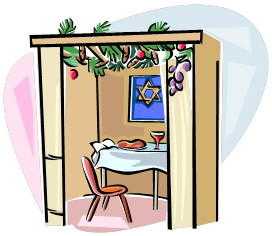SUKKOT- THE FEAST OF BOOTHS

Immediately after the breaking of the fast on Yom Kippur, the sound of hammers tapping can be heard in Jewish neighborhoods. A start is made in building the temporary booth or SUKKAH, in a backyard or on a balcony, which will be the center of the week-long Festival celebration. The booths, or sukkot, symbolize the temporary shelters that housed the Israelites during their forty-year journey through the wilderness en route to the Promised Land. A sukkah must have at least three walls and be big enough to eat a meal inside it. The main message of the sukkah lies in the fact that it is a temporary dwelling. It reminds us that our lives on earth are also temporary and just as God protected, guided and provided for His people on their precarious travels through the wilderness, so our Father will care for us as we undertake our tenuous journey through this world. As His children, we can joyfully, in complete faith and trust, rest in the knowledge that our true shelter is found in His constant Presence. …
SUKKOT- THE FEAST OF BOOTHS Read More »
